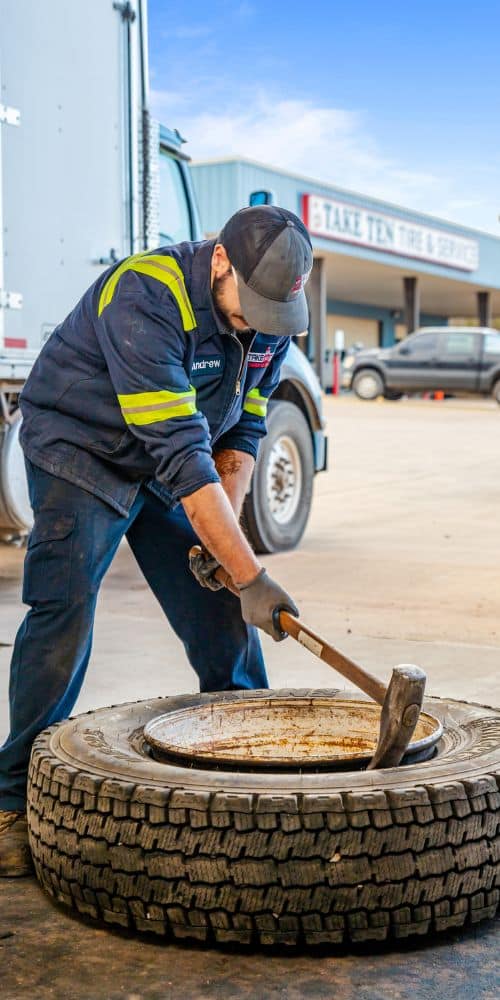Morris Tires: Your Location for GMC Tires Service Quality
Morris Tires: Your Location for GMC Tires Service Quality
Blog Article
Tire Service: The Impact of Weather
When it pertains to making certain optimum performance and security when driving, comprehending the impact of weather on tire service is vital. From scorching heat to icy roads, each climate element can considerably influence tire performance and general driving experience. By delving into the results of differing climate condition on tires, motorists can gain beneficial insights that may enhance their vehicle's efficiency and durability. In this discussion, we will certainly check out the complex partnership in between climate condition and tire solution, losing light on the importance of weather-specific tire upkeep techniques and factors to consider.
Warm and Tire Efficiency
When subjected to high temperatures, tires experience modifications in performance that can considerably impact car safety and handling. The warmth generated from long term driving or warm weather condition problems causes the tire rubber to soften, leading to reduced step life and raised wear.

Cold Climate Impacts
Cold weather problems can have a significant effect on tire efficiency and safety and security. In cold weather, tires may likewise shed air stress much more swiftly, which can impact taking care of and fuel performance.
To minimize the results of winter on tires, it is vital to regularly examine tire pressure and inflate them to the producer's advised degrees. Making use of wintertime or all-season tires designed for cold climate problems can likewise improve grip and grip on icy or snowy roads. Correct tire maintenance, including normal evaluations for wear and damage, becomes even a lot more important during colder months to ensure ideal performance and safety.
Rainy Conditions Influence
During stormy conditions, tire efficiency and security can be significantly affected by the wet roadway surface areas and decreased exposure. The tread pattern of tires plays an essential role in maintaining traction on wet roads. Tires with damaged treads are extra vulnerable to hydroplaning, where a layer of water builds up in between the road and the tire surface area, causing loss of traction. To combat this, chauffeurs must on a regular basis examine their tires for adequate tread deepness and take into consideration spending in tires specifically made for damp problems.
Additionally, rainy weather condition can additionally reduce exposure, making it testing for vehicle drivers to see the road ahead plainly (GMC Tire Service). In such conditions, it is vital to adjust driving speeds as necessary and maintain a risk-free following distance to allow for abrupt stops. Correctly filled with air tires can also help in maintaining control on damp roadways by giving much better handling and hold
Snow and Tire Security
Snow-covered roads posture distinct obstacles for drivers, highlighting the relevance of proper tire option and upkeep. When driving in snowy conditions, having the right tires can make a substantial distinction in safety and security and performance. Winter months tires are designed with special rubber compounds and walk patterns to supply much better traction on snow and ice contrasted to all-season tires. The deeper footsteps and sipes of winter months tires assist hold the roadway better, minimizing the threat of sliding and sliding.

It is vital to follow supplier guidelines when utilizing and installing tire chains to stop damages have a peek at this site to the tires and vehicle. helpful resources By picking the ideal tires, maintaining proper inflation, and thinking about additional traction aids like tire chains, drivers can boost their safety and security when navigating snow-covered roads.
Weather-Related Tire Upkeep
When confronted with various climate condition, correct tire upkeep becomes a crucial facet of car safety and security and performance. Weather-related tire maintenance incorporates a variety of practices focused on guaranteeing optimum tire feature and longevity in various climate circumstances. One key element of weather-related tire upkeep is tire stress law. Fluctuating temperatures can cause tire pressure to differ, influencing grip and fuel efficiency. Routinely examining and adjusting tire pressure according to producer recommendations is necessary for secure driving in changing weather condition problems. In addition, tire walk deepness plays a significant role in managing various weather components. Tires with ample walk deepness offer better grasp on wet or icy roadways, lowering the threat of hydroplaning or skidding. When step wear gets to a specific deepness is vital for keeping grip and security in adverse weather, inspecting tire tread frequently and replacing tires. By prioritizing weather-related tire maintenance, chauffeurs can improve security, boost lorry performance, and prolong the lifespan of their tires.
Verdict
In final thought, climate problems have a significant influence on tire efficiency and security. From warmth influencing tire stress and put on to chilly climate minimizing traction, it is important to take into consideration the weather condition when preserving and using tires.
In this discussion, we will certainly check out the complex partnership in between weather condition conditions and tire service, dropping light on the visite site relevance of weather-specific tire upkeep practices and considerations.

Report this page